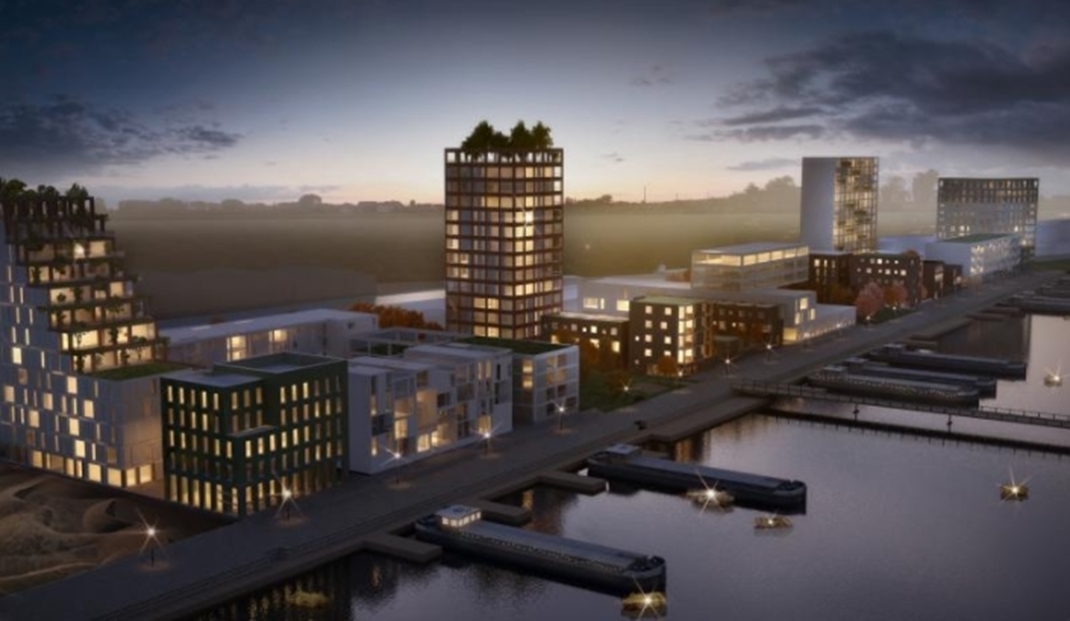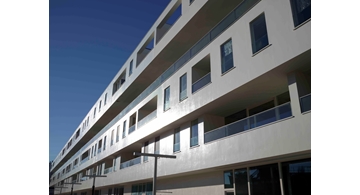De Nieuwe Dokken gives new oxygen to the north of Ghent. It concerns the redevelopment of a former port area for which no new open space was cut out, a so-called brownfield development.
The project comprises some 400 new flats, houses and will be supplemented with offices, various commercial functions (brasseries, shops, etc.) and the necessary parking facilities. These functions are all
These functions will all be surrounded by a green environment in the form of neighbourhood parks, promenades, etc.
The sustainability of this site is the key concept. This is monitored and assessed on the basis of the
sustainability meter of the city of Ghent with a score of 93.9%.
A high level of sustainability was put forward by the design and construction team. To this end, inspiration was drawn from various sustainability meters. As mentioned, the sustainability meter of the City of Ghent, but there is also a Breeam certification and GRO and LEVEL(s) were taken into account for inspiration.
During the design, the Quadras energetica was used (Energy Efficiency, energy recuperation, renewable energy and fossil fuel). This involves the insite production of heat and electricity through the conversion of local waste streams to energy by means of a ZAWENT power plant (Zero Waste Water with Energy and Nutrient Recovery). The black waste water is collected via vacuum toilets. This waste flow is anaerobically processed and fermented. This results in the production of biogas that is used as a source of energy. The grey wastewater is also purified and used as a heat source. The heat recovered from the wastewater and from the fermentation process is injected into the heat network that provides the homes and other functions with heat for heating and the production of domestic hot water. The residual heat from the Christeyns company next door is also used as an important heat source for the sustainable heat supply to the site.
The maximum net energy requirement of the various functions is also an ambitious figure. On top of that
one of the first residential projects, "de Faar", has been awarded Breeam Excellent certification. De Faar comprises about 45 flats, offices, retail spaces and 2 underground parking levels. For this, several sub-studies were carried out, among others:
Breeam Pre-assessment so that well-considered choices were made
The choice of materials was based on the Total Cost of Ownership
During the works, there was a separation of waste streams
Together with the safety coordinator, it was assessed that heavy traffic would be kept to a minimum from vulnerable road users. This was done by including correct approach times.
Comprehensive energy monitoring ensures that each user is responsible for their energy consumption. It is also used to quickly detect irregularities so that integrated maintenance can respond to them.
During commissioning, all aspects were thoroughly tested to ensure that all installations work well together.
Finally, we are already looking to the future. Because this project was developed in BIM as a Digital Twin, the model can be used as a material library when the buildings reach the end of their life cycle. This way, building materials can get a second life in another building.
Ingenium is part of the design team as sustainability advisor and designer of techniques. We perform among others
We perform, among others, the following tasks :
Comfort and daylight simulations
EPB reporting
BREEAM certification
Sustainability reporter
Elaboration of the complete technical equipment
Commissioning
…
Besides, Ingenium also supports the sustainable energy cooperative (DUCOOP) in setting up the low
heat network over the entire Nieuwe Dokken site. Ingenium evaluates the integral heat chain:
From impact on comfort and technical choices within the housing units, over heat distribution, to
heat production and storage. Ingenium also forms the link between the Ducoop cooperative and the
project developer in establishing technical preconditions. Ingenium supports Ducoop in
Subsidy applications and EPB regulations (e.g. application for equivalence).

